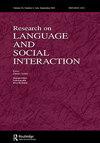On “Whistle” Sound Objects in English Everyday Conversation
IF 2.1
1区 文学
Q1 COMMUNICATION
引用次数: 11
Abstract
ABSTRACT In this article we study the forms and functions of whistling in social interaction. Our analysis identifies two basic forms of conversational whistling, (a) melodic whistling, when participants whistle the tune of, e.g., a familiar song; and (b) nonmelodic whistling. The focus in this article lies on nonmelodic whistles, which come in two contours linked to specific actions: (a) the tonal whistle deployed for summoning (e.g., a domestic animal but also human participants); and (b) the gliding whistle used for affect-laden responses to informings that breach a norm, often ones containing a numerical reference. The pitch contour used on the latter type of whistle matches those found for more lexical sound objects, e.g., oh, ah, and wow. The data base for the study comprises a wide range of audio and video recordings of mundane American and British English telephone and face-to-face conversations.论英语日常会话中的“哨音”宾语
摘要本文研究了口哨在社会交往中的表现形式和作用。我们的分析确定了会话口哨的两种基本形式,(a)旋律口哨,当参与者吹出熟悉歌曲的曲调时;和(b)非旋律的口哨声。本文的重点是非音调哨子,它有两个与特定动作相关的轮廓:(a)用于召唤的音调哨子(例如,家畜和人类参与者);以及(b)滑翔哨,用于对违反规范的信息做出充满感情的反应,通常是包含数字参考的信息。后一种类型的哨子使用的音高轮廓与更多词汇声音对象的音高轮廓相匹配,例如,哦、啊和哇。该研究的数据库包括广泛的美国和英国普通英语电话和面对面对话的音频和视频记录。
本文章由计算机程序翻译,如有差异,请以英文原文为准。
求助全文
约1分钟内获得全文
求助全文
来源期刊
CiteScore
7.30
自引率
7.40%
发文量
20
期刊介绍:
The journal publishes the highest quality empirical and theoretical research bearing on language as it is used in interaction. Researchers in communication, discourse analysis, conversation analysis, linguistic anthropology and ethnography are likely to be the most active contributors, but we welcome submission of articles from the broad range of interaction researchers. Published papers will normally involve the close analysis of naturally-occurring interaction. The journal is also open to theoretical essays, and to quantitative studies where these are tied closely to the results of naturalistic observation.

 求助内容:
求助内容: 应助结果提醒方式:
应助结果提醒方式:


